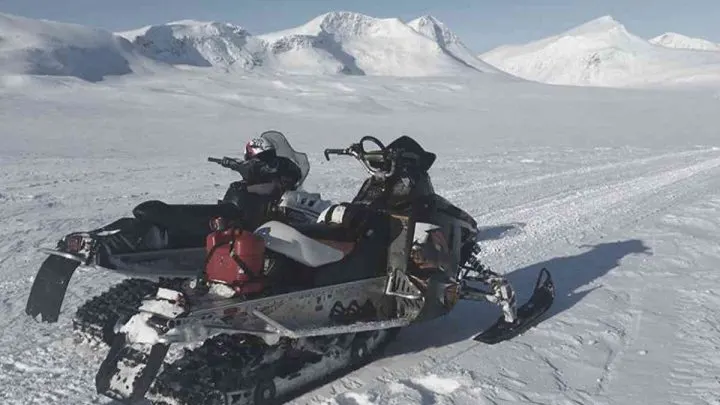It’s that time of year again when the snow starts to fly, and we all can’t wait to hit the tracks on snowmobiles. But what do you do if your sled is acting up and you suspect a damaged crankshaft? That’s when you pull out this guide.
To tell if your snowmobile crankshaft is bad, check for the following signs:
- Issues starting your sled
- Stalling
- Unusual noises
- Vibrations
- Uneven acceleration
- Reduced gas mileage
- Engine misfires
This article will go over each of these symptoms and explain what they mean for your snowmobile’s crankshaft. I’ll also share some tips for crankshaft inspection and maintenance.
1. Issues Starting Your Sled
Several things can cause starting issues on your sled, but a crankshaft issue sits high on that list. The culprit could be a broken crankshaft sensor or a problem with the bearings (source).
If you are having trouble starting your sled, it’s important to check for wear and tear on your crank. If it’s worn or damaged, you will need to replace it.
You might also be looking at a bent crankshaft. This can happen if you hit a big bump or rock on the trail. The result is a rough idle and difficulty starting the engine. If you think your crankshaft might be bent, take your sled to a mechanic or snowmobile dealer for inspection.
2. Stalling
I have seen many people with a stalling issue, and they almost always assume that it’s their carburetor. But in most cases, it’s the crankshaft.
A bent or damaged crankshaft will cause stalling because your motor is not getting the proper compression. This can be a big problem because your sled can stall at any point on the trail.
If this happens to you, you should first check the crankshaft for damage and replace it if it’s bent or damaged.
However, you can also be looking at a problem with the bearings. If they’re worn or damaged, they will need to be replaced as well.
3. Unusual Noises
It’s important to take notice if you hear any unusual noises coming from your sled because this could be a sign of a severe problem with the crankshaft.
One of the most common noises is a knocking sound. It is usually caused by a problem with the bearings and can lead to severe damage if it’s not fixed, so it’s important to take your sled to a mechanic or snowmobile dealer as soon as possible.
A grinding sound is another symptom of a failing crank. Several things can cause this, but the most likely culprit is a bent or damaged crankshaft. If you hear this noise, have the sled inspected by a professional ASAP.
4. Vibrations
Vibrations are tricky to diagnose because there are so many possible causes. So, you’ll never be 100% sure it’s a crank issue unless you notice another issue I’ve listed here.
One of the most common causes of vibration is a problem with the bearings. If they are worn or damaged, they will cause vibration. This issue is not only annoying but can also lead to serious damage.
Another possibility is that the crankshaft itself is bent or damaged. And this isn’t a DIY-friendly repair. You’ll need special tools and deep motor knowledge to pull this off without damaging anything.
5. Uneven Acceleration
If you notice that your sled is not accelerating evenly, it’s important to take notice because it could be a sign of a problem with the crankshaft.
A bent or damaged crankshaft will cause uneven acceleration because your motor is not getting the proper compression. This can be particularly dangerous, especially for inexperienced riders.
If you’re having trouble with uneven acceleration, you should first check the crankshaft for damage. If it’s bent or damaged, get it replaced.
6. Reduced Gas Mileage
A damaged crankshaft reduces your sled’s gas mileage for a few reasons:
- It causes the engine to work harder
- It causes the engine to run less efficiently
If you notice that your sled’s gas mileage has decreased, don’t ignore it. That could be a sign of a problem with the crankshaft.
You could also be looking at other non-crankshaft issues, such as a dirty air filter or carburetor. But if you’ve ruled those out, it’s time to take your sled to a mechanic or snowmobile dealer for inspection.
7. Engine Misfires
A healthy engine should fire evenly and smoothly. If you notice misfiring, it could be a sign of a damaged crank.
When an engine misfires, it means that the air/fuel mixture is not igniting properly in the cylinders. That can cause damage to the cylinders and pistons over time, so you’ll want to get it checked out immediately.
How To Diagnose a Faulty Crankshaft
Unfortunately, there’s no easy way to diagnose a faulty crankshaft on your own. Your only option is to take the sled to a mechanic or snowmobile dealer for inspection. They’ll be able to hook your sled up to a diagnostic machine and run some tests. That will help them identify the problem and get your sled back on the snow in no time.
If you have nothing to lose or are pretty handy with snowmobiles, you can open up your engine and take a look yourself. Once you have the crankshaft exposed:
- Check the connecting rods for cracks or damage.
- Inspect the crankshaft bearings for excessive wear.
- Look for cracks and metal shavings in the crankshaft itself.
- Check for lubrication.
If you notice any of these problems, it’s time to replace your crankshaft.
Over to You
A damaged crankshaft is no laughing matter. If you think you might have a problem, the best thing is to seek professional help. The last thing you want is to make a bad situation worse.
Still, I’ve seen people try to repair a crankshaft themselves. But if you attempt this, I recommend taking your time and doing proper research.
Recommended Reading:


